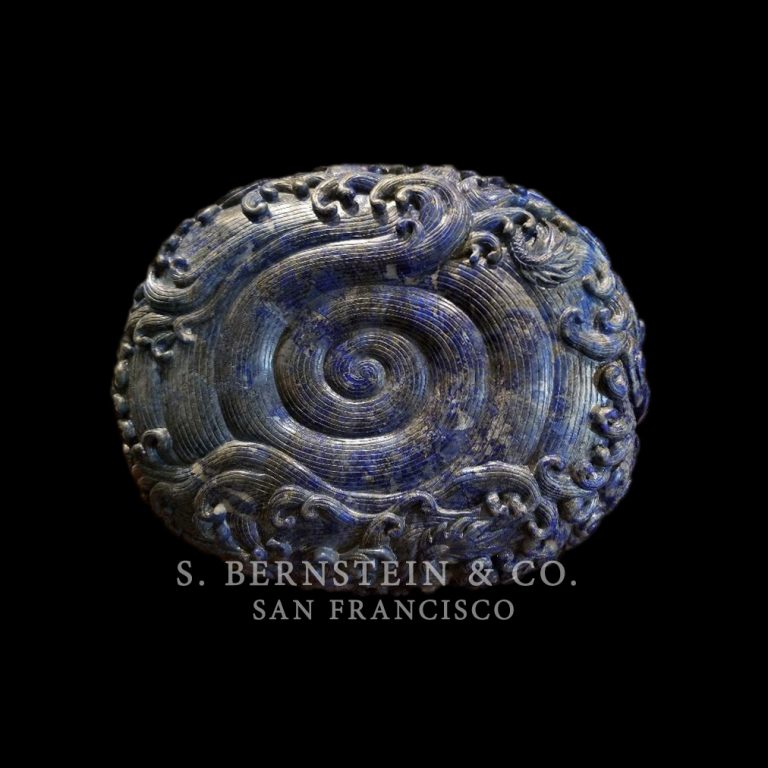


Lapis Lazuli, Chinese Workmanship
Qing Dynasty (清朝)
Diameter: 10 inches Height: 5 inches
The present alms bowl is a direct linear descendant of the great nephrite jade bowl of the Yuan dynasty, which resides in the Palace Museum of the Forbidden City in Beijing. James Watt refers to the Yuan large bowl as a prototype for the dragon enhancements. (Han to Ching, New York Ceramic Society, New York, page 22.) Hugh Moss describes a delightful dragon brush washer bowl, which is attributed to the Ming dynasty. He refers to the Yuan dynasty bowl as the derivation of this subject matter (Art of the Scholars Studio, Ceramic Society of Hong Kong, Plate 89, page 122.) The present bowl, rendered from a massive boulder of lapis lazuli, exemplifies elements of technical refinement and adaptation of subject matter, which are unique to this Qing Dynasty archaism. In our opinion, the subject matter, workmanship, size and quality of the lapis material suggests a Qing Dynasty century date for this remarkable work of art.
The iconography of this alms bowl depicts dragons swirling among clouds and waves. Between the dragons are flaming pearls, representing knowledge and success. Thus the dragon (representing the Emperor) achieves possession of the pearl of knowledge and becomes a good ruler in Confucian terms. The underside of the bowl continues the theme of waves, which are elegantly rendered. The overall coloration is of brilliant blue with pyrite markings. The characteristic appearance of the material suggests that the origin of the original lapis lazuli boulder was in the Middle East and hence traveled by trade route to the workshops located in China.
With fitted Stand
Reference number 3617
Price Available Upon Request
Formerly in a distinguished American collection.
A circular spinach green jade dragon bowl approximately 11 1/4 inches long and 9 1/2 inches high attributed to the Seventeenth century resides in the Margaret and Trammell Crow Collection and is published in Immortal Images: The Jade Collection of Margaret and Trammel Crow. Alex Kerr, Crow Family Interests, Dallas, 1989. Page 54.
A jade dragon bowl of similar design of the Eighteenth century bearing the Imperial Seal is shown in the Illustrated Catalogue of The Remarkable Collection of the Imperial Prince Kung of China, The American Art Association. New York, 1913. Plate 109.
A jade example, presently in the collection of the Smithsonian Institution and formerly in the Vetlesen Collection, is illustrated in Chinese Jade of Five Centuries, Joan M. Hartman, Rutland, Vermont: Charles E. Tuttle, 1969. Plate 8, page 54.
A similar carved jade bowl attributed to the Ming dynasty can be seen in the catalog Jade and Chinese Culture, Palm Springs Desert Museum. Palm Springs, California, 1990. Plate 74, page 79.
A similar Eighteenth century jade dragon bowl is in the collection of the Palace Museum and published in Chinese Arts Series: Chinese Jades, vol. 6 Qing, Li Jiufang, ed. Shijiazhuang; Hebei Art Publishing, 1991. Plate 333, p. 226.
A jade oval basin with a similar dragon and cloud motif, previously attributed to the Early Ming period, can be found in the Avery Brundage Collection. Also illustrated in Chinese Jades in the Avery Brundage Collection, Rene- Yvon Lefebvre d’Argence, Asian Art Museum of San Francisco, 1977. Plate XL, page 94.
A massive jade dragon basin attributed to the late Sixteenth / early Seventeenth centuries of celadon colored nephrite marked with russet streaks approximately 12 3/4 inches long formerly in the collection of Edward I. Farmer, New York, 1930 and exhibited in Selections of Chinese Art, China House, New York, 1967, catalogue number 6 is presently in the collection of Alan and Simone Hartman and published in Chinese Jades from the Collection of Alan and Simone Hartman. Robert Kleiner, New York, 1996. Pages 48-9, Plate 45.
To inquire about this work of art, contact us at 415.299.1600 or email at sbernsteinjade@aol.com
